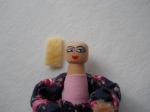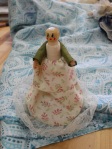The hair
You can paint the hair onto the peg as I did the on the doll at the beginning of this project or make hair as I have done below:
1) Use a piece of felt similar to the colour of the peg or the colour of the hair. Cut a small rectangle about 1.5m long by 0.5cm.

2) Choose the thread colour for the hair. I have used an embroidery cotton but you could use wool or silk or anything else that takes your fancy! I have chosen pink! Wrap the thread around four of your fingers about 10 times. Widen your fingers if you want longer hair, wrap around less fingers for shorter hair.

3) Remove the wraps from your fingers and flatten

4) Put some glue on one side of the piece of felt, and glue the threads to the felt in the centre. Use a craft glue


5) You can work a backstitch along the centre if you like to look like a parting in the hair. This will also ensure the threads stay in place. Use a thread the same colour as the hair.


6) Turn the hair over and put some glue on the back of the felt piece.

7) Glue to the head and hold in place until dry. Tie the hair in bunches, plait (braid) the hair or leave loose!


The finished doll:


This is a quite basic doll, and is a great point from which to develop other dolls. We will look at accessories and more complicated doll clothing in future posts, but in the meantime, why not experiment for youself?
I would love to see pictures of any finsihed dolls! You can e-mail them to me here:
dollypegdoll@yahoo.co.uk


























